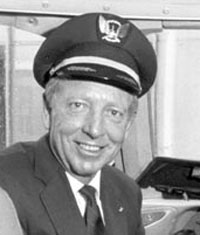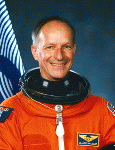|
CAPT. AL HAYNES
2002 Kom Captain Al Haynes og taladi vid nemendur og kennara.

On 19 July, 1989 United Airlines Flight 232 was enroute from Denver to Chicago. At about 4:00 p.m., with First Officer William Records at the controls, the aircraft experienced a catastrophic failure of the number two (center) engine. The DC-10 is a favored aircraft among pilots mainly because of its ability to experience such failures and return to earth safely. As Captain Al Haynes, the hero of UAL 232 said later, "The DC-10 has three engines; you only need one to fly." This, coupled with its triply-redundant hydraulic systems, meant that an accident of the type that UAL 232 experienced had odds against of something like a billion to one. And the odds of a flight crew coping with such an emergency as competently as did the crew of UAL 232 are practically non-existent.
What happened was, a manufacturing defect in the fan blade of the number two engine resulted in increasingly worse metal fatigue every time the engine was operated. Seventeen years worth of routine maintenance and six fluoroscopic examinations had failed to reveal the defect. On the afternoon of 19 July, 1989 the stress on the defect reached the breaking point. In the course of one revolution, the stricken fan broke into hundreds of shards, which sprayed explosively from the engine housing and peppered the horizontal stabilizer and the cone section of the tail. All three hydraulic lines were severed, instantaneously making moot the designers contingency of redundant hydraulic systems. With all hydraulics gone, the aircraft lost all ability to control the ailerons, rudders, flaps, spoilers, landing gear brakes and nosewheel steering. It was a systems loss so catastrophic, and presumably so remote, that no one had ever planned for its eventuality. If anyone had ever thought about it, they would have written it off as a non-survivable accident.
But luck was not completely against the 285 passengers and 11 crew. Good fortune was immediately discovered when Dennis Fitch, a deadheading United pilot and DC-10 instructor, came foreward to offer his assistance. Fitch, Haynes and Records began controlling the aircraft the only way they could: with the engine throttles. They found that by carefully feathering the one and three engines, they could effect right or left turns. They still had no control over pitch or airspeed, but since the craft was already in a slightly nose-down attitude, they found they could slowly lose altitude simply by circling. They had been flying at 37,000 feet when the accident occurred; they managed to descend to 9,000 feet by the time they began lining up for their approach to Sioux City Gateway.
More good luck: timing and location. The accident occurred over the Midwestern plains instead of the Rockies. Had the accident happened earlier in the flight and UAL 232 attempted to return to Denver, the chance of anyone surviving the wreck would have been remote indeed. The accident occurred over Sioux City, Iowa; a city that boasts one of the most competent EMS structures in the nation, and a city perhaps more prepared than any other at the time to mobilize for a mass-casualty incident. It was 4:00 p.m., shift change, when the citys emergency medical elements were notified of the stricken aircraft circling above. All hospitals, ambulance companies and fire stations held over their day personnel and were thus double-staffed. Finally, 19 July was the one day that month that the 185th Iowa Air National Guard was training, at their airfield adjacent to Sioux City Gateway. As Al Haynes lined up with runway 22, Sioux City, Iowa was as ready as any city could possibly be to deal with disaster.
The images of that flaming DC-10 cartwheeling down the runway and into a cornfield have become one of the most enduring in recent memory. One hundred people lost their lives. But 185 survived. The incredible airmanship that not only brought UAL 232 back to earth, but actually put the nosewheel nearly on the runway centerline, is nearly beyond comprehension. In fact, nearly every DC-10 pilot in the world has tried to replicate the feat of Haynes and Fitch in the simulator, and have never been able to do so. Al Haynes, Dennis Fitch and William Records deny to this day that they did anything extraordinary, but the world begs to differ. So much went wrong that day, but so much more went right. And three exceptional pilots became lifesavers and heroes.
Enter supporting content here

Fekk taekifaeri 9, mars 2003 ad fljuga med Claude i CRJ flugherminum okkar herna i Phoenix.
CLAUDE NICOLLIER
ESA ASTRONAUT
PERSONAL DATA: Born September 2, 1944, in Vevey, Switzerland. Married to the former Susana Perez of Monterrey, Mexico. They have two daughters, Maya and Marina. He enjoys mountain climbing, flying, and photography. His father, Mr. Georges Nicollier, resides in La Tour de Peilz, Switzerland.
EDUCATION: Graduated from Gymnase de Lausanne (high school), Lausanne, Switzerland, in 1962; received a bachelor of science in physics from the University of Lausanne in 1970 and a master of science degree in astrophysics from the University of Geneva in 1975. Also graduated as a Swiss Air Force pilot in 1966, an airline pilot in 1974, and a test pilot in 1988 (Empire Test Pilots School, Boscombe Down, United Kingdom).
ORGANIZATIONS: Member of the Swiss Astronomical Society, the Astronomical Society of the Pacific, the Swiss Air Force Officers Society (AVIA), and the Swiss Academy of Engineering Sciences. Fellow of the British Interplanetary Society. Honorary member of the Swiss Aero Club, and the Swiss Society of Engineers and Architects.
SPECIAL HONORS: NASA Distinguished Service Medal (2001), Four NASA Space Flight Medals (1992, 1993, 1996, 1999), Prix d'honneur de la Fondation Pro Aero, Switzerland (1992), Yuri Gagarin Gold Medal from the International Aeronautical Federation (1994), Silver Medal from the Académie Nationale de l'Air et de l'Espace, France (1994), Collier Trophy (awarded to the crew of STS-61) from the National Aeronautics Association (1994), Prix de l'Université de Lausanne (1994), honorary doctorates from the Swiss Federal Institute of Technology, Lausanne, and the Geneva University (both in 1994). Appointed professor at the Swiss Federal Institute of Technology, Lausanne, in November 1994.
EXPERIENCE: From 1970 to 1973, Claude worked as a graduate scientist with the Institute of Astronomy at Lausanne University and at the Geneva Observatory. He then joined the Swiss Air Transport School in Zurich and was assigned as a DC-9 pilot for Swissair, concurrently participating part-time in research activities of the Geneva Observatory. At the end of 1976 he accepted a Fellowship at the European Space Agencys (ESA) Space Science Department at Noordwijk, Netherlands, where he worked as a research scientist in various airborne infrared astronomy programs. In July 1978 he was selected by ESA as a member of the first group of European astronauts. Under agreement between ESA and NASA he joined the NASA astronaut candidates selected in May 1980 for astronaut training as a mission specialist.
His technical assignments in the Astronaut Office have included flight software verification in the Shuttle Avionics Integration Laboratory (SAIL), participation in the development of retrieval techniques for the Tethered Satellite System (TSS), Remote Manipulator System (RMS), and International Space Station (ISS) robotics support. From the Spring of 1996 to the end of 1998, he was Head of the Astronaut Office Robotics Branch. From the year 2000 to date, he was assigned to the Astronaut Office EVA (Extravehicular Activity) Branch, while maintaining a position as Lead ESA astronaut in Houston.
Claude holds a commission as captain in the Swiss Air Force. He has logged 5,600 hours flying time--including 4,000 hours in jet aircraft.
A veteran of four space flights, Claude has logged more than 1,000 hours in space including 1 space walk totaling 8 hours and 10 minutes. He served on STS-46 in 1992, STS-61 in 1993, STS-75 in 1996, and STS-103 in 1999.
SPACE FLIGHT EXPERIENCE: STS-46 Atlantis (July 31-August 8, 1992), was an 8-day mission during which crew members deployed the European Retrievable Carrier (EURECA) science platform, and conducted the first Tethered Satellite System (TSS) test flight. Mission duration was 191 hours, 16 minutes, 7 seconds. STS-46 was launched from and returned to land at Kennedy Space Center, Florida. The mission was accomplished in 126 orbits of the Earth and traveled 3.35 million miles in 191 hours, 16 minutes and 7 seconds.
STS-61 Endeavour was the first Hubble Space Telescope (HST) servicing and repair mission. STS-61 launched at night from the Kennedy Space Center, Florida, on December 2, 1993. During the 11-day flight, the HST was captured and restored to full capacity through a record five space walks by four astronauts. After having traveled 4,433,772 miles in 163 orbits of the Earth in 259 hours, 59 minutes.
STS-75 Columbia (February 22 to March 9, 1996) was a 15-day flight, with principal payloads being the reflight of the Tethered Satellite System (TSS) and the third flight of the United States Microgravity Payload (USMP-3). The TSS successfully demonstrated the ability of tethers to produce electricity. The TSS experiment produced a wealth of new information on the electrodynamics of tethers and plasma physics before the tether broke at 19.7 km, just shy of the 20.7 km goal. The crew also worked around the clock performing combustion experiments and research related to USMP-3 microgravity investigations used to improve production of medicines, metal alloys, and semiconductors. The mission was completed in 252 orbits covering 6.5 million miles in 377 hours and 40 minutes.
STS-103 Discovery (December 19-27, 1999) was an 8-day mission during which the crew successfully installed new instruments and upgraded systems on the Hubble Space Telescope (HST). Enhancing HST scientific capabilities required three space walks (EVA) totaling 24 hours and 33 minutes. The STS-103 mission was accomplished in 120 Earth orbits, traveling 3.2 million miles in 191 hours and 11 minutes.
|

